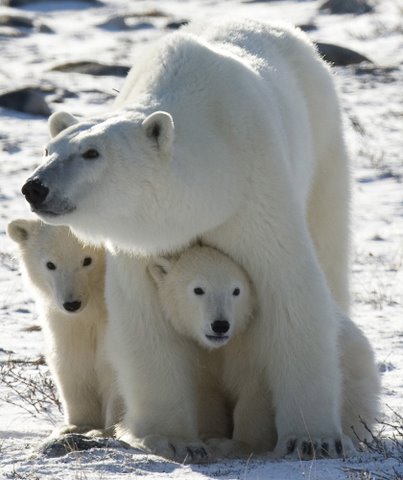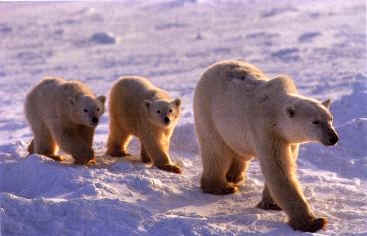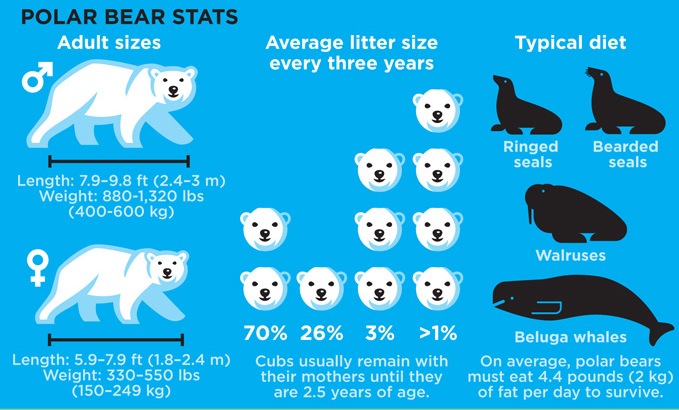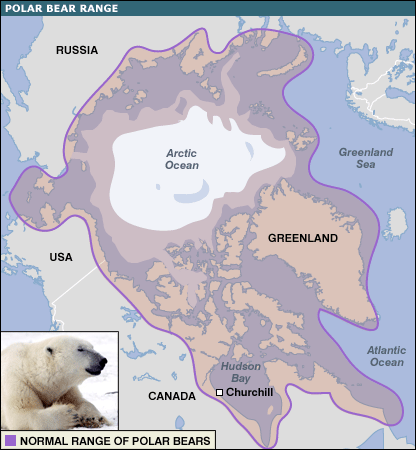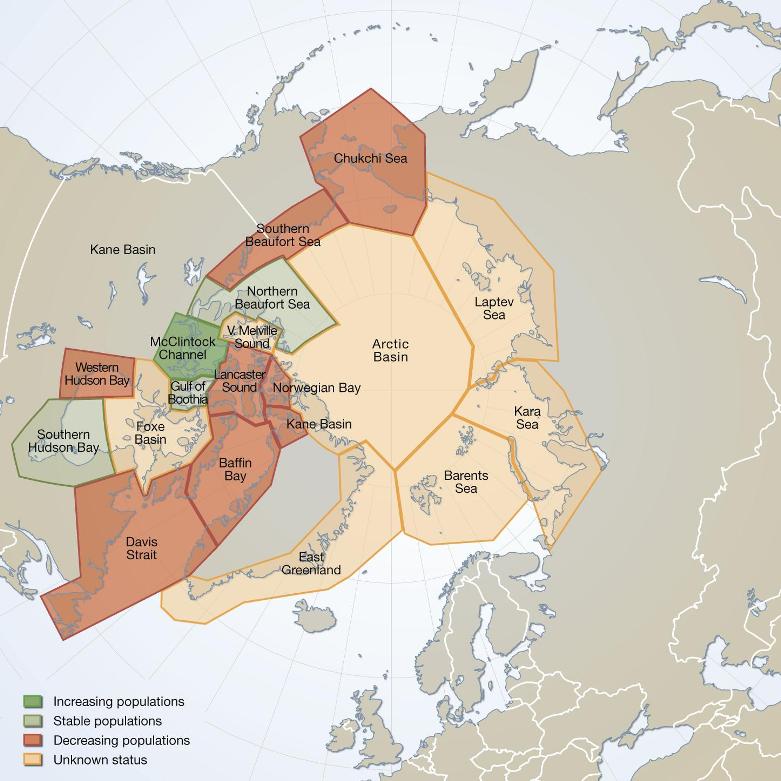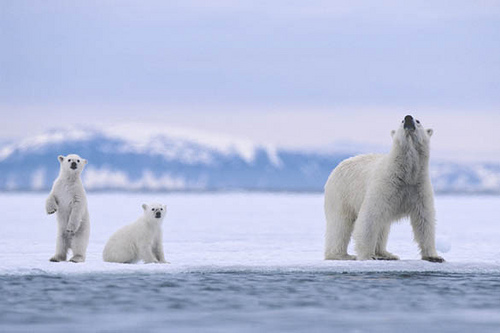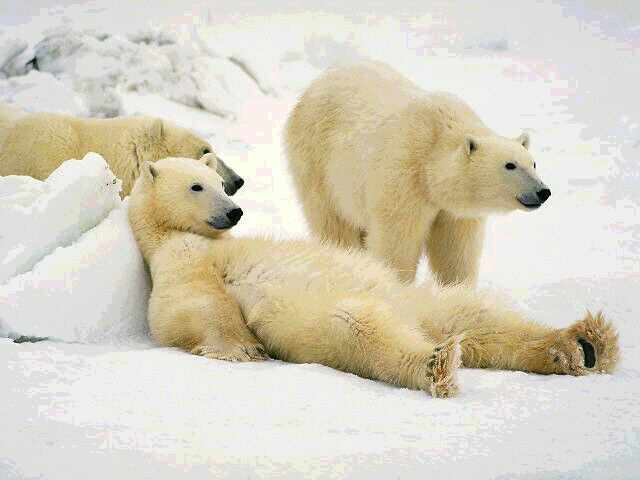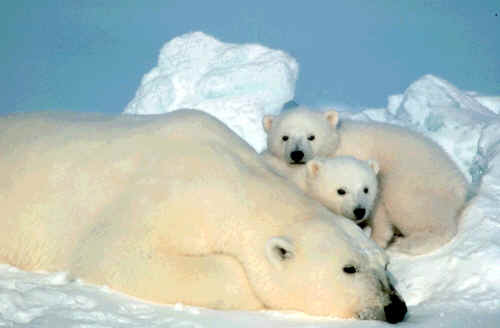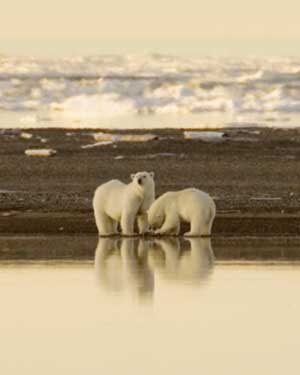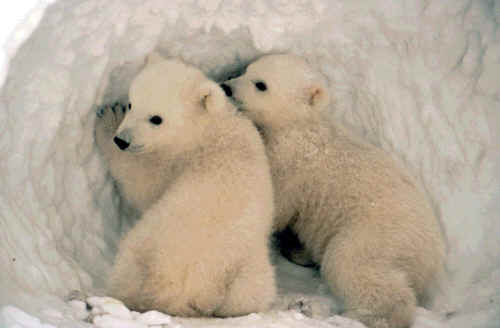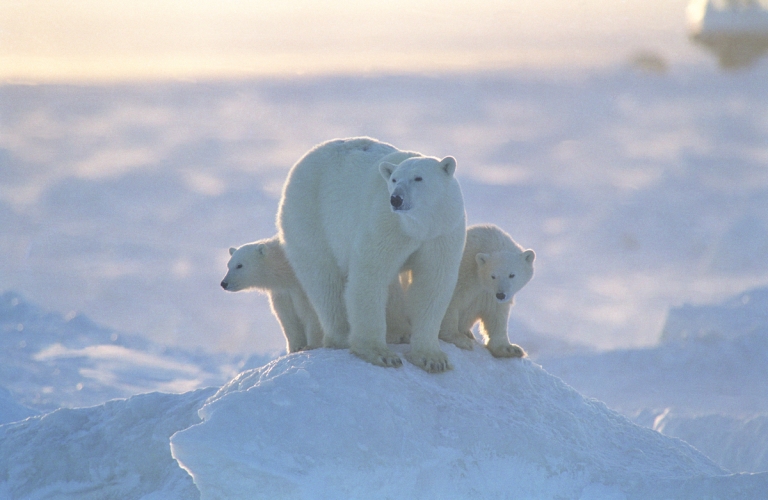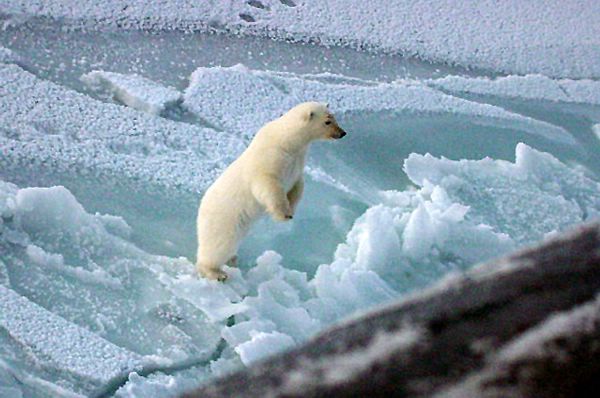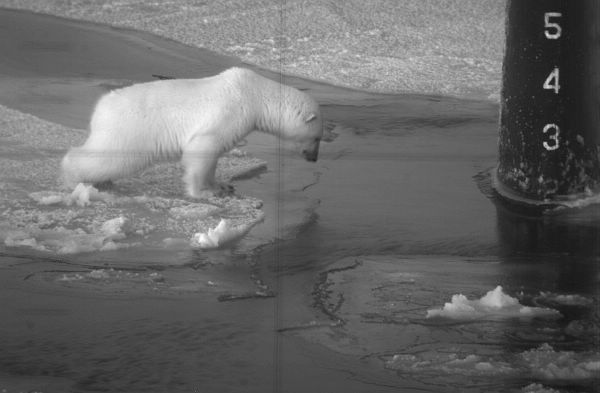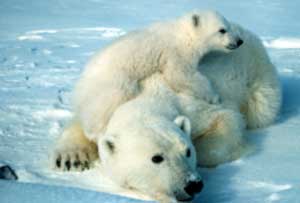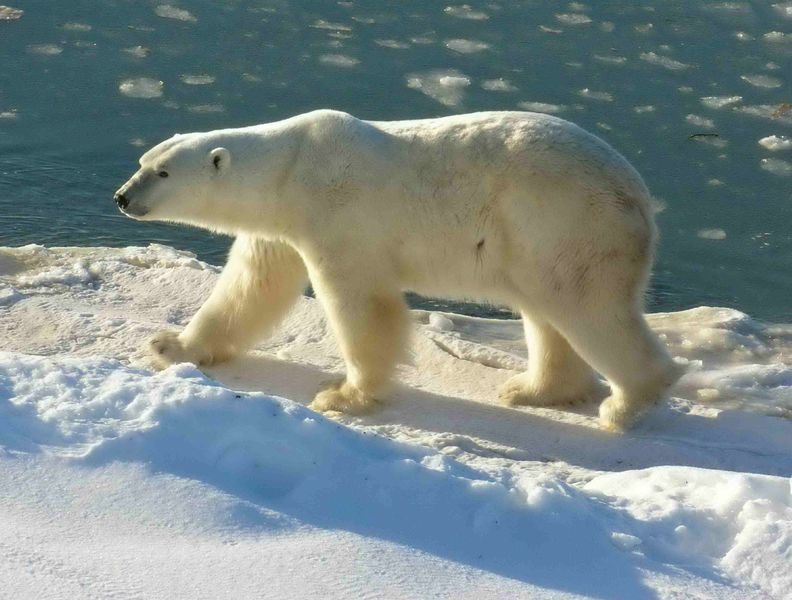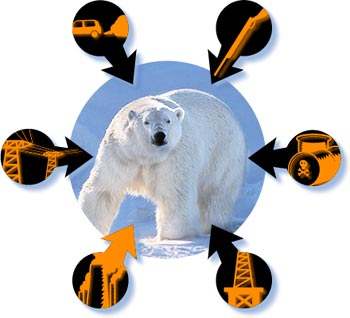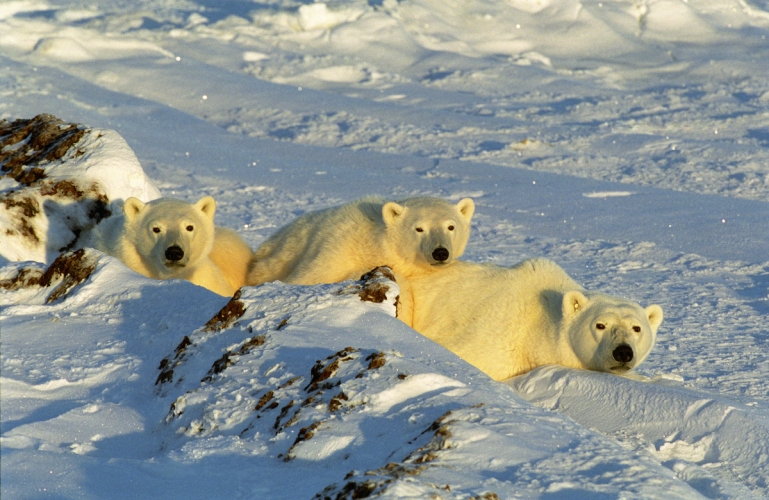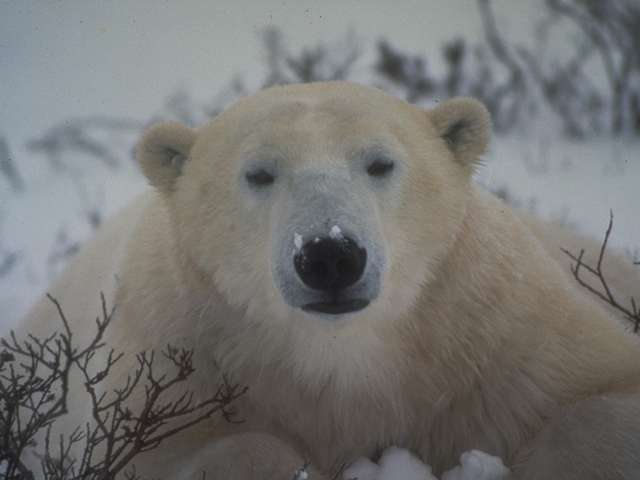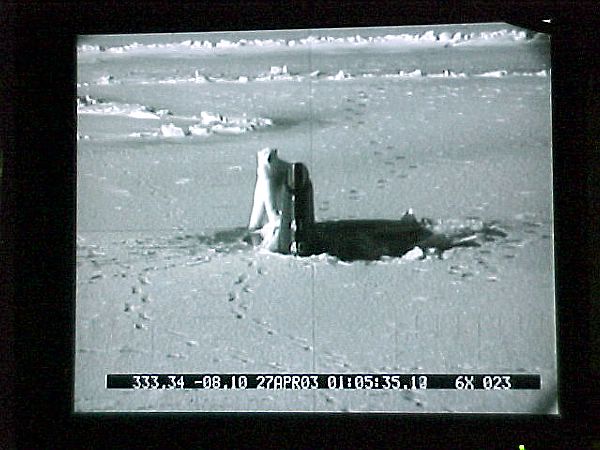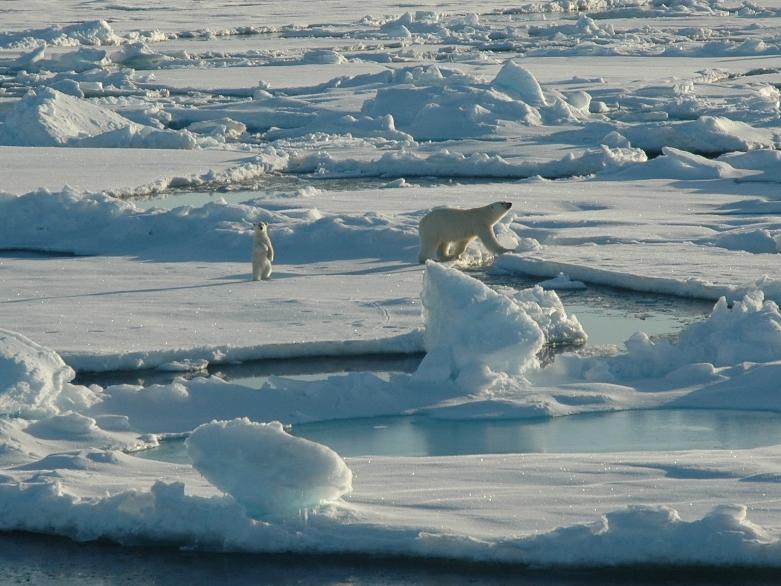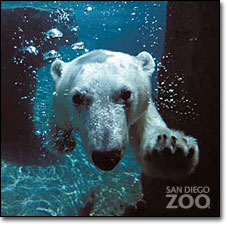
|
||||||||||||
|
|
|
Polar Bears
Polar bears inhabit Arctic sea ice, water, islands, and continental coastlines
Biologists estimate their population at 22,000 to 27,000 bears, of which around 15,000 are in Canada.
Class:
Mammalia (Mammals)
From United Nations Environment Programme (UNEP) Polar bears spend much of their time at or near the edge of the pack ice. This is where they are most likely to find food. As the southern edge of the arctic ice cap melts in summer, some bears will follow the retreating ice north to stay close to seals and other prey. Other bears spend their summers on land, living off body fat stored from successful hunting in the spring and winter. When the ice returns in the fall, the bears leave land to resume life on the sea ice.The world's southern-most polar bears live year-round in James Bay, Canada. The species range extends as far south as the winter maximum sea ice extent and includes adjacent land masses
The polar bear, or “Nanuuq,” as the Eskimos call it, lives only in the Northern Hemisphere, on the arctic ice cap, and spends most of its time in coastal areas. Polar bears are widely dispersed in Canada, extending from the northern arctic islands south to the Hudson Bay area. They are also found in Greenland, on islands off the coast of Norway, on the northern coast of the former Soviet Union, and on the northern and northwestern coasts of Alaska in the United States. Some polar bears may make extensive north-south migrations as the pack ice recedes northward in the spring and advances southward in the fall. They also may travel long distances during the breeding season to find mates, or in search of food. A polar bear rides a summer sea-ice raft off Norway's Svalbard archipelago. Sea ice provides crucial habitat for the Arctic's top predator, but warming temperatures are creating extended ice-free periods that tax bears. www.visionsofthewild.com Appearance The polar bear is the largest member of the bear family, with the exception of Alaska’s Kodiak brown bears, which equal polar bears in size. Males stand from 8 to 11 feet tall and generally weigh from 500 to 1,000 pounds, but may weigh as much as 1,400 pounds. Females usually stand 8 feet tall and weigh 400 to 700 pounds, but may reach 700 pounds. Part of the reason the polar bear weighs so much is that it stores about a 4-inch layer of fat to keep it warm. The polar bear has a longer, narrower head and nose, and smaller ears, than other bears.
Although the polar bear’s coat appears white, each individual hair is actually a clear, hollow tube. Some of the sun’s rays bounce off the fur, making the polar bear’s coat appear white. During the summer months, adult bears molt, or gradually shed their coats and grow new ones, which look pure white. By the following spring, the sunshine has caused their coats to turn a yellowish shade. Polar bears also sometimes may have a yellowish shade to their coats caused by staining from seal oils. Polar bears live on ice and snow, but that’s not a problem—these bears have some cool ways to stay warm!
Photographer Florian Schulz watched a Svalbard male (background) stalk a female with two cubs, alert to danger
The polar bear’s coat helps it blend in with its snow-covered environment, which is a useful hunting adaptation. The polar bear’s front legs appear slightly bowllegged and pigeon-toed, and fur covers the bottoms of its paws. These adaptations help the polar bear keep them from slipping on ice.
Feeding Habits Polar bears are mainly meat eaters, and their favorite food is seal. They will also eat walrus, caribou, beached whales, grass, and seaweed. Polar bears are patient hunters, staying motionless for hours above a seal's breathing hole in the ice, just waiting for a seal to pop up. Because the polar bear rarely eats vegetation, it is considered a carnivore, or meat-eater. The ringed seal is the polar bear’s primary prey. A polar bear may stalk a seal by waiting quietly for it to emerge from its blow hole or “atluk,” an opening seals make in the ice allowing them to breathe or climb out of the water to rest. The polar bear will often have to wait for hours for a seal to emerge. Because the polar bear’s coat is camouflaged against the whiteness of the ice and snow, the seal may not see the bear. Polar bears typically eat only the seal’s skin and blubber, or fat, and the remaining meat is an important food source for other animals of the Arctic. For example, Arctic foxes feed almost entirely on the remains of polar bear kills during the winter. Polar bears also prey on walrus, but, because of the walrus’s ferocity and size, bears are usually only successful preying on the young. The carcasses of whales, seals, and walrus are also important food sources for polar bears. In fact, because of their acute sense of smell, polar bears can sense carcasses from many miles away.
Credit: USFWS
Polar bears can cover significant distances on land, but are most agile in the sea. They are excellent swimmers, and can reach speeds of up to 6 mph in the water. They are good divers, too. When being pursued by hunters in open water, polar bears have been known to escape by plunging 10 to 15 feet below the surface and resurfacing a good distance away. They also have been seen swimming 100 miles or more from ice or land.
Credit: Steve Hillebrand / USFWS Reproduction Polar bears reach breeding maturity at 3 to 5 years of age. Males may travel great distances in search of female mates. While breeding usually takes place in April, the embryos may not implant (develop) until the following year, depending on whether the mother has had a stable enough supply of food to sustain herself while allowing her to feed the developing cubs through the winter.
Credit: USFWS In October and November, male polar bears begin to head out on the pack ice where they spend the winter. Pregnant females, however, seek sites on the mainland or on sea ice to dig large dens in snow where they will give birth and spend the winter. The temperature inside the polar bear’s den can be as much as 40 degrees warmer than outside. Usually two cubs are born in December or January. When the cubs first arrive, they are blind, hairless, and no bigger than squirrels. However, the cubs grow rapidly from the rich milk provided by their mother. As soon as spring comes, the mother bear leads her cubs to the coast along the open sea, where seals and walrus are abundant. The mother will fiercely protect her cubs from any perceived danger. The cubs remain with their mother for 2-1/4 years. Because of this, most adult female polar bears breed only every third year.
Protection Polar bears have traditionally played an important role in the culture and livelihood of Eskimos and other Native people of the North. They depend on the animals for food and clothing. In the United States, polar bears are a federally protected species under the Marine Mammal Protection Act of 1972. This protection prohibits hunting of polar bears by non-Natives and establishes special conditions for the importation of polar bears or their parts and products into the United States. Eskimos and other Alaska Natives are allowed to harvest some polar bears for subsistence and handicraft purposes. The U.S. Fish and Wildlife Service is the federal agency responsible for managing polar bears under the Marine Mammal Protection Act.
Arctic Circle (Oct. 2003) -- Three Polar bears approach the starboard bow of the Los Angeles-class fast attack submarine USS Honolulu (SSN 718) while surfaced 280 miles from the North Pole. Sighted by a lookout from the bridge (sail) of the submarine, the bears investigated the boat for almost 2 hours before leaving. Commanded by Cmdr. Charles Harris, USS Honolulu while conducting otherwise classified operations in the Arctic, collected scientific data and water samples for U.S. and Canadian Universities as part of an agreement with the Artic Submarine Laboratory (ASL) and the National Science Foundation (NSF). USS Honolulu is the 24th Los Angeles-class submarine, and the first original design in her class to visit the North Pole region. Honolulu is as assigned to Commander Submarine Pacific, Submarine Squadron Three, Pearl Harbor, Hawaii. U. S. Navy photo by Chief Yeoman Alphonso Braggs.
A young Polar bear stands up to get a better look at the Los Angeles-class fast attack submarine USS Honolulu (SSN 718) while surfaced 280 miles from the North Pole.U. S. Navy photo by Chief Yeoman Alphonso Braggs
As seen through the periscope of the Los Angeles-class fast attack submarine USS Honolulu (SSN 718), a young Polar bear investigates the open water around the submarine’s rudder U. S. Navy photo by Chief Yeoman Alphonso Braggs An international conservation agreement for polar bears signed in 1976 by the United States, the former Soviet Union, Norway, Canada, and Denmark (Greenland) also provides for cooperative management of polar bears. The Fish and Wildlife Service and the United States Geological Survey’s Alaska Science Center work together to monitor polar bears in Alaska, where they number approximately 4,700, and study their behavior. Cooperative efforts with Canada involve monitoring polar bears in the Beaufort Sea, and the agencies work with the Russian government to monitor the animals in the Chukchi Sea.
Polar bear with cub. Credit: Scott Schliebe/USFWS Another treaty, the “Agreement between the Government of the United States of America and the Government of the Russian Federation on the Conservation and Management of the Alaska-Chukotka Polar Bear Population,” unifies the American and Russian management programs that affect this shared population of bears. Notably, the treaty calls for the active involvement of Native people and their organizations in future management programs. It will also enhance long-term joint efforts such as conservation of ecosystems and important habitats, harvest allocations based on sustainability, collection of biological information, and increased consultation and cooperation with state, local, and private interests. The Fish and Wildlife Service also undertakes education and outreach efforts to inform the public about how polar bears can be protected from over-harvest.
Polar Bear at Cape Churchill (Wapusk National Park, Manitoba, Canada) photo taken by Ansgar Walk
Polar Bears at Risk
In Alaska, demands for oil, natural gas, and other resources have led to some conflicts between polar bears and humans. A number of protective measures have been taken to reduce human activities along the coast in polar bear denning areas. This is when the animals are most sensitive to outside disturbances. For example, oil and gas pipelines and roads have been routed to avoid these areas. The Fish and Wildlife Service also provides expertise to industries on how to minimize conflicts with bears while conducting their operations. Today it is estimated that there are 20,000 to 25,000 polar bears worldwide. With continued cooperative management, these great marine mammals, and the unique arctic environment on which they depend, can be protected for generations to come.
Polar bears range throughout the Arctic in areas where they can hunt seals at open leads. The five "polar bear nations" where the ice bears are found include the U. S. (Alaska), Canada, Russia, Denmark (Greenland), and Norway.
Near the North Pole (Apr. 27, 2003) -- During Exercise ICEX 2003, the Seawolf-class attack submarine USS Connecticut (SSN 22) surfaced and broke through the ice. This polar bear, attracted by the hole which can be used to find food, was seen through the sub's periscope and these photos were captured as the image was projected on a flat-panel display. After investigating the Connecticut for approximately 40 minutes, the bear left the area, with no damage to the sub or to the bear. U.S. Navy photo by Mark Barnoff
Biologists estimate their population at 22,000 to 27,000 bears, of which around 15,000 are in Canada. In 1973, the five nations with polar bear populations (Canada, Denmark, which governed Greenland, Norway, the U.S., and the former U.S.S.R.) entered into the International Agreement for the Conservation of Polar Bears. Here is what they encounter in each nation:
A polar bear cub curiously stands on its hind legs while its mother stays
nearby. The two bears approached within 200 meters of the ship. Scientists analyzing decades of data from Arctic Sea ice recently reported a significant reduction in the thickness of the ice during the last decade. The scientists found a decrease in sea ice all across the Arctic Ocean. Polar bears need sea ice so they can hunt for seals. A retreat and loss of sea ice could make it harder for these animals to get enough food. Pregnant females and those with cubs may be particularly at risk.
\ To find out more about Polar Bears visit the sites below by clicking on the logos
Credit: U.S. Fish & Wildlife Service, San Diego Zoo, Sea World, NOAA, International Bear Association, United States Navy |
